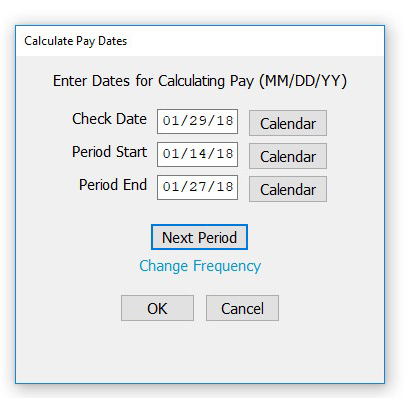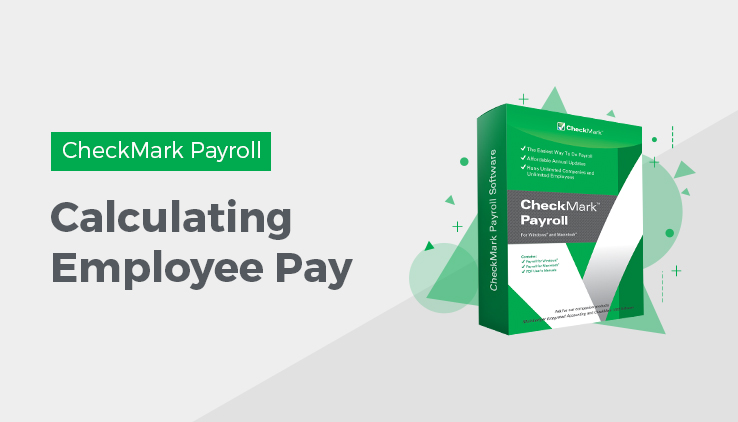
This article shows you how to calculate employee pay in CheckMark Payroll for employee paychecks and special checks, such as bonuses and after-the-fact paychecks.
CheckMark Payroll program can calculate the pay for one employee at a time or all employees for any combination of pay frequencies at one time.
After you’ve entered employee hours with the Enter Hours or Distribute Hours window (you can also enter hours on the Calculate Pay window), the next step is to have CheckMark Payroll calculate employee wages, additional income and deduction amounts, taxes, and net pay for the current pay period.
Check Dates
When you first open the Calculate Pay screen, you will see the Claculate Pay Dates window. You need to enter the Check Date, Period Start and Period End dates. Use the DOWN ARROW buttons to the right of the Check Date, Period Start and Period End fields to use the pop-up calendars. Click on the date of the calendar window for the date to fill in the appropriate field. When the dates are filled in, Click OK to continue to the Calculate Pay window. Dates entered in the Check Dates window are displayed on the Calculate Pay window while you are calculating your employee paychecks.
Next Period: This button will calculate Check Date, Period Start and Period End based on the pay frequency set on the first employee in the employee list and dates currently being displayed.
Change Frequency: If you have multiple pay frequencies, you can click the Change Frequency link to open up a option to change the pay frequency when selecting the Next Period button.
Calculate Pay
Once you are in the Calculate Pay window, you will see all employees in your employee list displayed on the right side of the screen. Employee names displayed in “black” indicate that there is no calculation saved for that employee. If the employee name is displayed in “green” with a “$” on the left side, there is a saved calculation for that employee. If that calculation is not correct, or needs to be modified, you must first Undo the saved calculation.
Make any changes to the payroll on the Calculate Pay window by clicking the box with the field you need to modify and insert the change. Save changes and review the calculation on the Review/ Create Paychecks window.
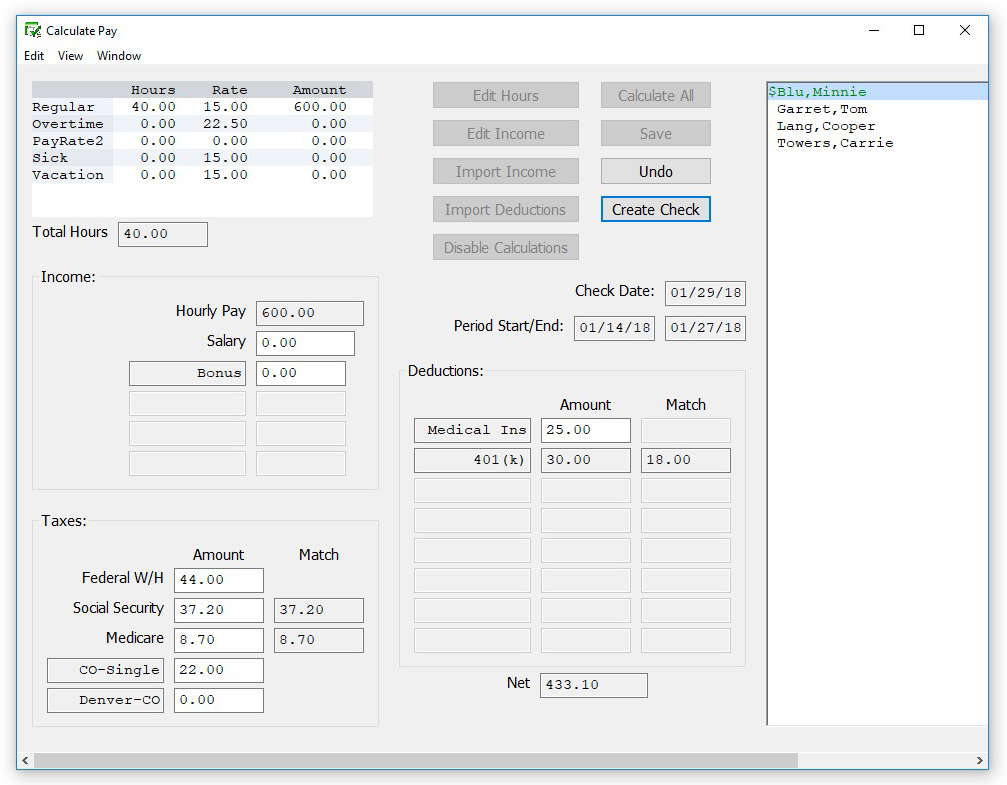
Edit Hours: Select Edit Hours if you need to adjust the number of hours or wage per hour for the pay period. Hours entered on the Enter Hours window can be edited directly in Calculate Pay, but if hours were entered in Distribute Hours, you will need to edit hours on the Distribute Hours window. An employee name must be selected before this option is available.
Changing the hourly rate on the Edit Hours window affects only the current calculation and does not change the employee’s hourly rate for future pay calculations.
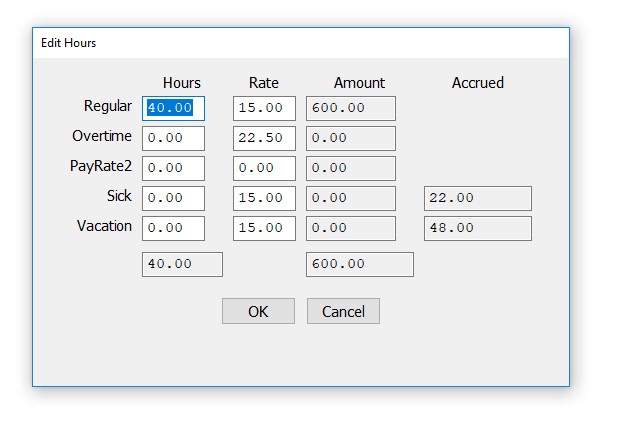
Edit Income: Select Edit Income if you need to enter information for an additional income that is setup to calculate based on further information, such as mileage, commission, piecework or tips. An employee name must be selected before this option is available.

Import Income: Select Import Income if you wish to import the additional incomes for your employees using a tab-delimited text file. An example is listed below for two employees. One employee, Jennifer Brown, has additional Commission and the other, James Wilcox, has additional Piecework and Mileage.
Brown[TAB]Jennifer[TAB]Commission[TAB]2500.00[RETURN] Wilcox[TAB]James[TAB]Piecework[TAB]127.5[TAB]Mileage[TAB]105.
9[RETURN]
Import Deduction: Select Import Deductions if you wish to import the variable deductions for your employees using a tab-delimited text file. An example is listed below for two employees. One employee, Jennifer Brown, has a reimburse deduction and the other, James Wilcox, has Office supplies.
Brown[TAB]Jennifer[TAB]reimburse[TAB]2500.00[RETURN] Wilcox[TAB]James[TAB]Office[TAB]127.5[RETURN]
Numbers that are imported in this way will be used in calculations setup on the Additional Income window or as the number used as additional income in the payroll calculation. These numbers can be modified, if necessary under the Edit Income option.
Disable Calculation: Select this option if you wish a deduction to be turned off for this payroll, for hour accrual to not accrue on this check or to disable all the calculations when entering checks such as after-the-fact payroll checks. Items selected in this window will affect all calculations made while you are in the Calculate Pay window. To deselect any or all of the options in this window, close Calculate Pay and re-enter the window.
If this option is unavailable, you probably have an employee selected in the list. Deselect the employee and try again.
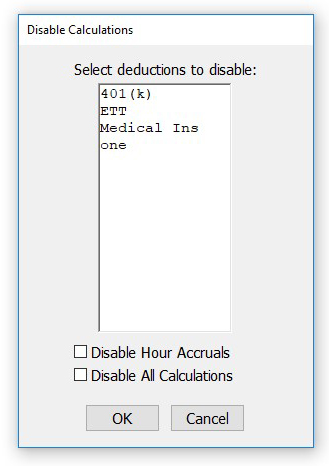
Select any or all deductions that you do NOT wish to calculate on this paycheck. For example, when calculating special checks such as bonus checks, you may not wish for items such as health insurance or 401(k) to be deducted. Select those items from the list then click OK.
Disable Hour Accrual – Select this option if you are doing a special check and do not wish employee accruals to calculate on this check. An example is an employee that has accrual based on a per pay period basis and you are calculating a bonus check in addition to a regular paycheck on the same check date.
Disable All Calculations – Select this option if you wish to manually enter all of the employee income, tax and deduction fields such is the case when entering after-the-fact checks.
Note: An employee’s Social Security and Medicare withholding are exact computations based on values shown for Federal Tax Parameters on the Federal Taxes Setup window and should NOT be manually changed for an individual check. There are, however, times when this is necessary specifically when entering after-the-fact checks since items already distributed MUST be matched exactly. CheckMark Payroll will warn you that these items do not match the calculated value, even when Disable Calculations is selected, BUT will allow the change to be saved.
Calculate All: Select this option if you wish to have CheckMark Payroll calculate all employees in the pay period at one time based on your company and employee setup. When you select this option, a list of possible pay frequencies appears. Select any or all pay frequencies that you wish to calculate pay. All frequencies enabled are those that appear and have been assigned to employees on the Wages tab of the Employees window.
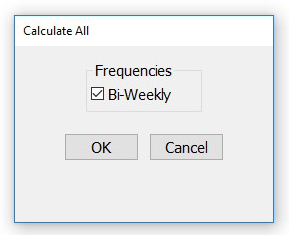
Save: Select this option after you have finished editing the employee’s pay calculation.
Undo: Select this option if you wish to undo an employee’s saved calculation. CheckMark Payroll deletes the saved calculation and removes the “$” from the employee’s name turning from “green” to “black” again. If you select Undo with no employee name selected from the employee list, ALL calculations that have been saved will be deleted.
Create Check: Select this option if you wish to create the employee’s paycheck directly in this window and not on the Review/Create Paychecks window. CheckMark Payroll will not affect employee YTD balances or create reports without creating an employee paycheck. Once the check or direct deposit number is entered, click Create
Calculating Pay for an Employee
- Click Payroll in the Command Center, then select Calculate Pay.
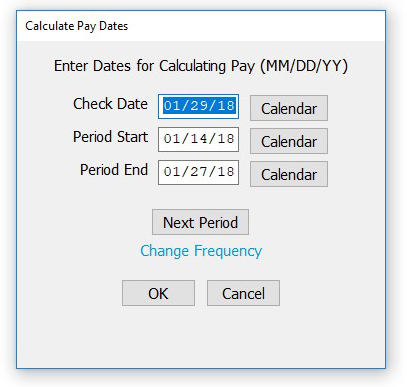
- Enter the check date for this payroll and press TAB.
- Enter the pay period start date and pay period ending date and click OK.
Note: To make date entry more accurate, you can select the down arrows next to Check Date, Period Start, and Period End date fields to reveal a calendar. Then, simply click the date on the calendar to fill in the appropriate date field. You can also use the Next Period advance button to move ahead one pay period at a time. The Next Period button will calculate check date, period start and end dates based on the pay frequency set on the first employee in the employee list and dates currently being displayed.
The Calculate Pay Window appears.
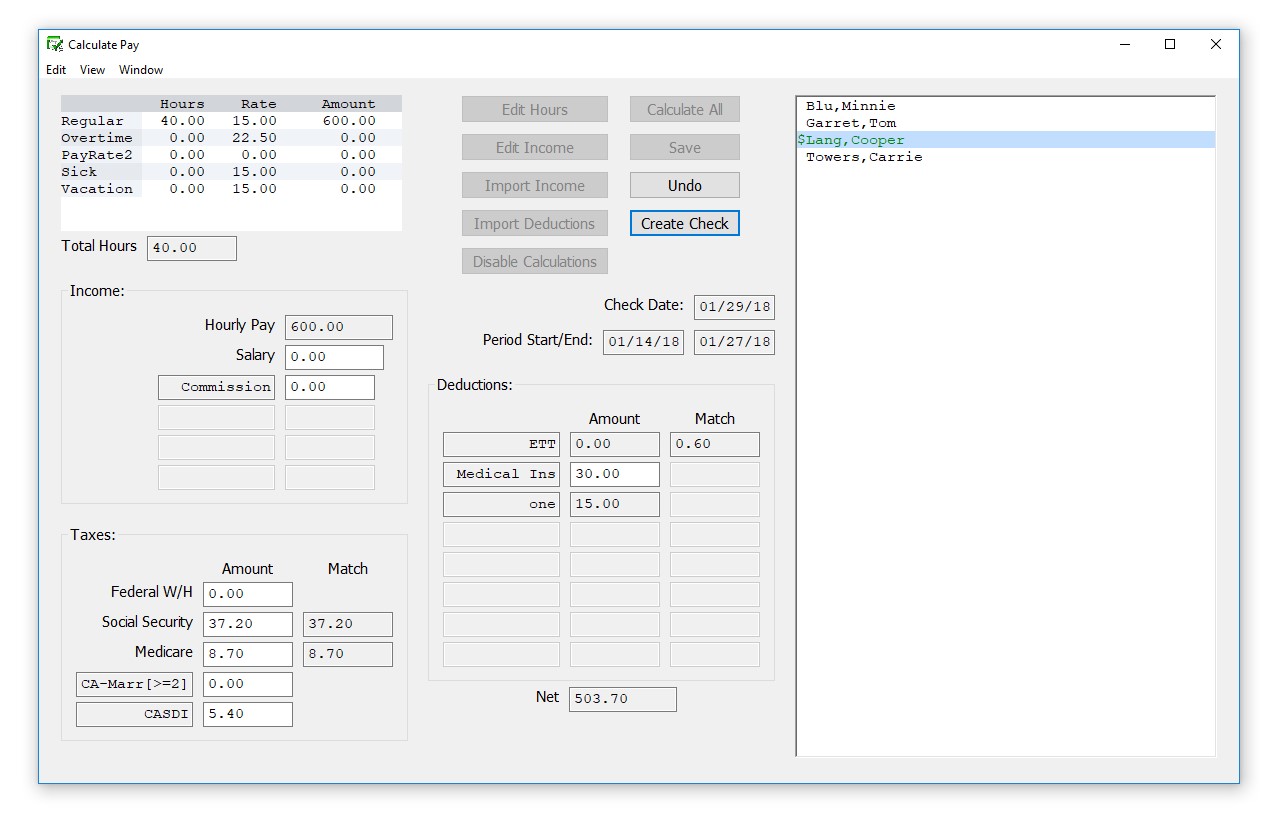
- Select an employee from the Employees list.
Important: An employee’s Social Security and Medicare withholding are exact computations based on values shown for Federal Tax Parameters on the Federal Taxes window and typically should not be manually changed for an individual check.
CheckMark Payroll Software calculates the tax withholding amounts using a percentage method, which is more accurate than manual calculations based on the bracket method used in the Circular E, Employers Tax Guide or state tax guide. You might find small differences (up to one or two dollars for federal or state withholding) between manual calculations and CheckMark Payroll’s calculations. You don’t need to be concerned about these minor differences.
The employee’s net pay is shown at the bottom of the window.
- Make any necessary changes to the wages shown for the employee.
To enter or modify hours for the employee, click the Edit Hours button.
Note: Hours entered in the Distribute Hours screen cannot be modified on the Calculate Pay screen. Close the Calculate Pay screen and modify in the Distribute Hours screen.
Hours shown for salaried employees do not affect the wage calculations unless the employee has also been set up with hourly pay rates.
- Make any necessary changes to the Additional Income amounts.
Don’t forget to enter amounts for any Variable Amount Additional Income for this pay period.
Whenever a taxable Additional Income amount is changed, CheckMark Payroll recalculates the appropriate taxes and net pay when the cursor leaves the edit box or the calculated pay is saved.
- Make any necessary changes to Deduction amounts.
Don’t forget to enter amounts for any Variable Amount Deductions for this pay period.
Whenever a pre-tax Deduction amount is changed, CheckMark Payroll recalculates the appropriate taxes and net pay when the cursor leaves the edit box or the calculated pay is saved.
Important: Do not enter negative amounts to account for mistakes made in prior payrolls. Example, if you over paid or over deducted someone on the prior payroll, don’t enter a negative amount to compensate for the over deduction or payment. This will adversely affect the tax reporting. You should create a new Deduction or Additional Income category to properly handle the misappropriated amount.
Employer Match Fields in Calculate Pay Screen
Modifying hours worked and other income amounts will force employer match amounts to recalculate. Changing a regular deduction amount will also force the employer match amount to recalculate, even if disabling deduction calculations. You can modify match amounts for Deductions, but not Taxes.
Fixed % employer matches cannot be modified, unless disabling calculations (which works the same as regular Deduction amounts.
The match amount cannot be modified on a deduction where the deduction amount is zero, and the “match if no employee deduction” checkbox is NOT checked, unless using Disable Calculations.
Note: Employer match amounts for taxes are calculated at the time reports are generated, not when checks are created. Changing employer tax rates though Federal Tax Values at any time will result in the employer match amounts for all previously created checks to change as well.
- Click Save after you’ve finished editing the employee’s pay calculations.
Employees whose calculated pay has been saved are shown in green and prefaced with a dollar sign ($):
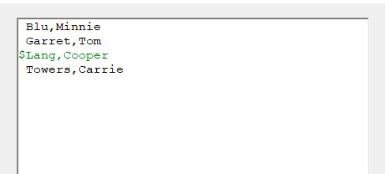
You can verify these calculations on the Review/Create Paychecks window before creating the paychecks. For details, see “Reviewing Payroll Calculations.”
After calculating employee pay, you can create the paychecks with the Review/Create Paychecks window. For details, see “Creating Payroll Checks.”
Note: CheckMark Payroll does not add the calculated pay to employee records until you create the paychecks.
Calculating Pay for Special Checks
You can use the Calculate Pay window to calculate the pay for special checks, such as after-the-fact or bonus checks.
Calculating Pay for After-the-Fact Checks
After-the-fact paychecks are paychecks that were issued in the current quarter prior to using CheckMark Payroll. If you have started using CheckMark Payroll mid-year and have used another program or service for previous payrolls, any check in the current quarter needs to be calculated and created in order to get accurate quarterly reports. If you want CheckMark Payroll to keep accurate records for quarterly reports, such as 941s and state reports, you should record these paychecks.
CheckMark Payroll automatically calculates net pay based on the amounts you enter for Wages, Additional Income, Deductions, and Taxes.
- Click Payroll in the Command Center, then select Calculate Pay.
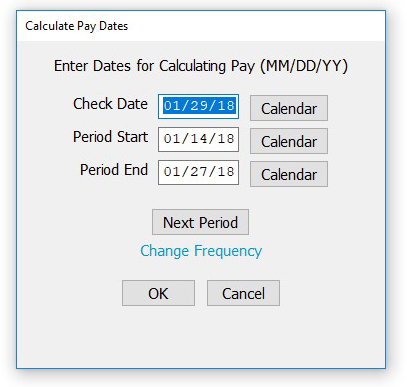
- Enter the check date from the original paycheck and press TAB.
- Enter the period start date and period ending date from the original paychecks and click OK.
- The Calculate Pay window appears.
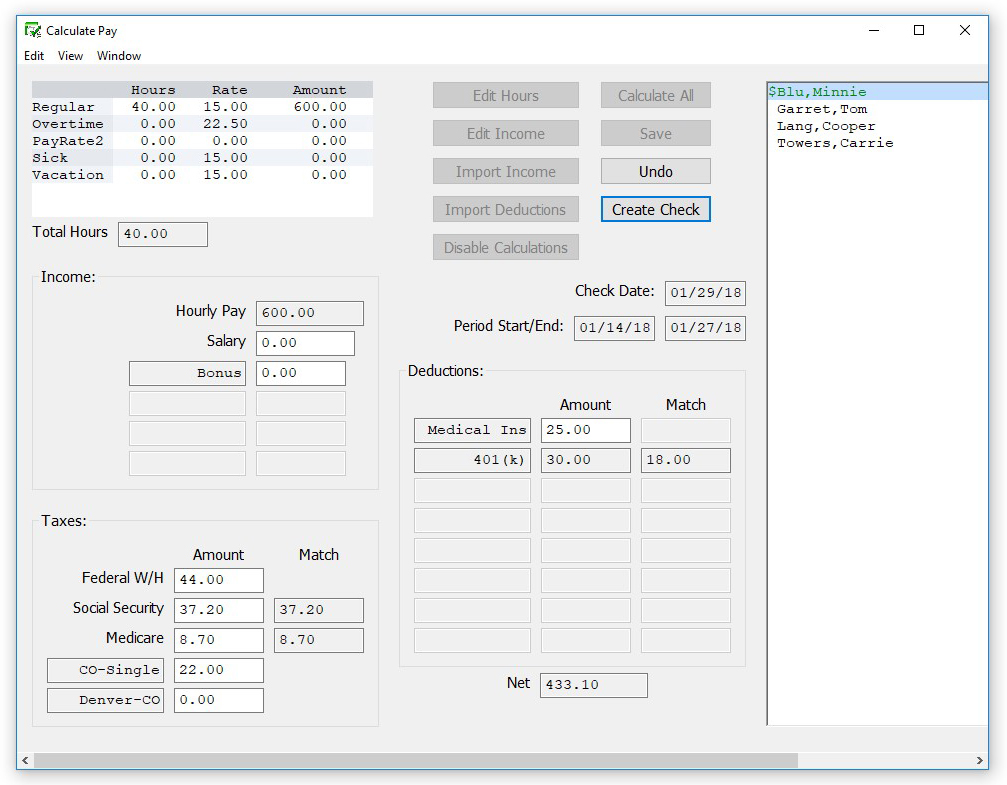
- Select Disable Calculations, then choose the Disable All Calculations check box.
- Select an employee from the list.
- Enter the check amounts from the employee’s paycheck in the appropriate fields.
If you don’t want to enter the hours to calculate the wages for hourly employees, you can enter the amount in the Salary edit box.
Note: Social Security and Medicare are exact computations based on values entered for Federal Tax Parameters on the Federal Taxes window. If you enter Social Security and Medicare amounts that differ from what the federal tax parameters calculate, CheckMark Payroll warns you that Social Security and Medicare are not correct. Typically you would override the amount to reflect what was actually paid, but you should know that the difference will appear in the Fractions of Cents line on the 941. For more information, see “Types of Federal Tax Reports.”
- Click Save after you have finished filling in the paycheck amounts.
Employees whose calculated pay has been saved are shown in green and prefaced with a dollar sign ($).
Important: Do not forget to use the Review/Create Paychecks window to create the paycheck since CheckMark Payroll updates employee records after the paycheck is created. Use the same check number that was originally disbursed for accuracy. For details, see “Creating Payroll Checks.”
Calculating Pay for a Bonus Check
Before calculating a bonus check, the bonus should have been set up for employees as an additional income category. For details, see “Adding Pre-Defined Additional Income Categories to Your Company.”
To calculate the pay for a bonus check, do the following:
- Click Payroll in the Command Center, then select Calculate Pay.
- Enter the date for the bonus check and press TAB.
- Enter the period start and period ending date and Click OK.
- Select Disable Calculations and select any deductions that don’t apply to this bonus.
Note: It may be necessary to select the Disable Accrual check box while on the Disable Calculations window. If you accrue hours such as vacation on a per pay period basis and you are doing a regular paycheck with a bonus check on the same check date, this check box will prevent accruals to occur twice, once for each check created.
- Select an employee from the list.
- If necessary zero out the salary and/or saved hours.
- Enter the bonus amount in the edit box for the Additional Income category that was set up for the bonus and press TAB.
![]()
- Change the amounts shown for federal, state, or local taxes if necessary.
For guidelines about how much federal tax should be withheld, consult the “Supplemental Wages” section in your Circular E, Employer’s Tax Guide.
For guidelines about how much state or local tax should be withheld, consult your state or local tax guides.
- Click Save.
Employees whose calculated pay has been saved are shown in green and prefaced with a dollar sign ($).
Repeat steps 4–8 for each employee who is receiving a bonus for the pay period.

